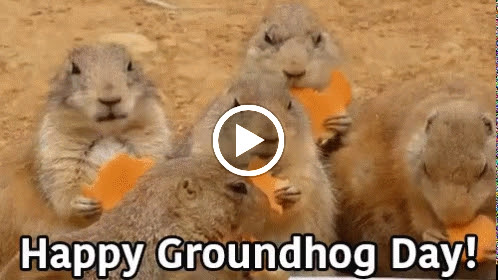GroundHog Day - Maayu was looking forward to GroundHog not seeing his shadow, but it turned out to be other way.
GroundHog Day - Maayu was looking forward to GroundHog not seeing his shadow, but it turned out to be other way. Though dejected, Maayu knew that GroundHog prediction was not right last year.
1. What is GroundHog Day?
On every February 2nd in Punxsutawney, Pennsylvania, Punxsutawney Phil, a GroundHog would help in forecasting the severity of the winter.
2. What is the legend?
If Phil were to see his own shadow, then the winter is expected to be severe, and would last for six more weeks. If not, then the winter is expected to be milder.
3. What is the history?
The GroundHog day happens to be the midpoint (middle of astronomical winter) between winter solstice and spring equinox.
If the day happens to be sunny, then the latter 8 weeks is expected to be cold and severe, whereas, if cloudy then the spring is expected to come sooner.
4. When did this start in Punxsutawney?
Clymer H. Freas, a local newspaper editor started this tradition in 1887, and called the local group as Punxsutawney GroundHog club.
Over time, other newspapers picked up, and made it a famous and regular event.
5. How accurate is the prediction of GroundHog?
GroundHog has seen shadow in 103 years since 1887 and no shadow for 18 years with no record for 10 more years.
GroundHog was found to be accurate ~39% of the times, but the accuracy increased to 47% when GroundHog did not see his shadow.
6. What else could we decipher based on the information available? (Inferential Analytics - New from our side)
- GroundHog data appears to be biased to shadow
- During the last thirty years, GroundHog has not seen the shadow during 9 years, though only 30%, that happens to be 50% of all (18) of 120 years of recorded information when Phil did not see the shadow (Does it have to do with climate changes.?)
- Percentage of spring coming sooner is well above the toss of a coin during the 120 years since Phil started predicting the severity of winter (Could be connected to the method of determining early spring)
References:
http://www.stormfax.com/ghogday.htm
https://www.ncdc.noaa.gov/customer-support/education-resources/groundhog-day
http://www.researchhistory.org/2012/02/02/feb-2-1887-first-groundhog-day/




1. What is GroundHog Day?
On every February 2nd in Punxsutawney, Pennsylvania, Punxsutawney Phil, a GroundHog would help in forecasting the severity of the winter.
2. What is the legend?
If Phil were to see his own shadow, then the winter is expected to be severe, and would last for six more weeks. If not, then the winter is expected to be milder.
3. What is the history?
The GroundHog day happens to be the midpoint (middle of astronomical winter) between winter solstice and spring equinox.
If the day happens to be sunny, then the latter 8 weeks is expected to be cold and severe, whereas, if cloudy then the spring is expected to come sooner.
4. When did this start in Punxsutawney?
Clymer H. Freas, a local newspaper editor started this tradition in 1887, and called the local group as Punxsutawney GroundHog club.
Over time, other newspapers picked up, and made it a famous and regular event.
5. How accurate is the prediction of GroundHog?
GroundHog has seen shadow in 103 years since 1887 and no shadow for 18 years with no record for 10 more years.
GroundHog was found to be accurate ~39% of the times, but the accuracy increased to 47% when GroundHog did not see his shadow.
6. What else could we decipher based on the information available? (Inferential Analytics - New from our side)
- GroundHog data appears to be biased to shadow
- During the last thirty years, GroundHog has not seen the shadow during 9 years, though only 30%, that happens to be 50% of all (18) of 120 years of recorded information when Phil did not see the shadow (Does it have to do with climate changes.?)
- Percentage of spring coming sooner is well above the toss of a coin during the 120 years since Phil started predicting the severity of winter (Could be connected to the method of determining early spring)
References:
http://www.stormfax.com/ghogday.htm
https://www.ncdc.noaa.gov/customer-support/education-resources/groundhog-day
http://www.researchhistory.org/2012/02/02/feb-2-1887-first-groundhog-day/




Comments
Post a Comment